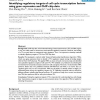Free Online Productivity Tools
i2Speak
i2Symbol
i2OCR
iTex2Img
iWeb2Print
iWeb2Shot
i2Type
iPdf2Split
iPdf2Merge
i2Bopomofo
i2Arabic
i2Style
i2Image
i2PDF
iLatex2Rtf
Sci2ools
BMCBI
2007
2007
Identifying regulatory targets of cell cycle transcription factors using gene expression and ChIP-chip data
Background: ChIP-chip data, which indicate binding of transcription factors (TFs) to DNA regions in vivo, are widely used to reconstruct transcriptional regulatory networks. However, the binding of a TF to a gene does not necessarily imply regulation. Thus, it is important to develop methods to identify regulatory targets of TFs from ChIP-chip data. Results: We developed a method, called Temporal Relationship Identification Algorithm (TRIA), which uses gene expression data to identify a TF's regulatory targets among its binding targets inferred from ChIP-chip data. We applied TRIA to yeast cell cycle microarray data and identified many plausible regulatory targets of cell cycle TFs. We validated our predictions by checking the enrichments for functional annotation and known cell cycle genes. Moreover, we showed that TRIA performs better than two published methods (MA-Network and MFA). It is known that coregulated genes may not be co-expressed. TRIA has the ability to identify sub...
| Added | 12 Dec 2010 |
| Updated | 12 Dec 2010 |
| Type | Journal |
| Year | 2007 |
| Where | BMCBI |
| Authors | Wei-Sheng Wu, Wen-Hsiung Li, Bor-Sen Chen |
Comments (0)

